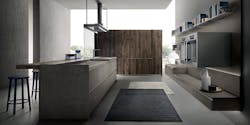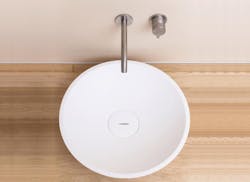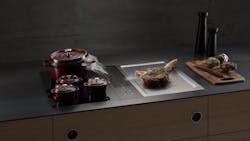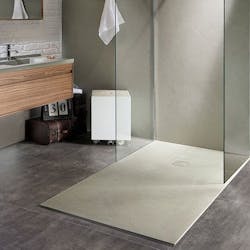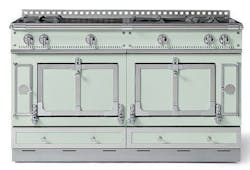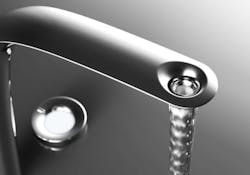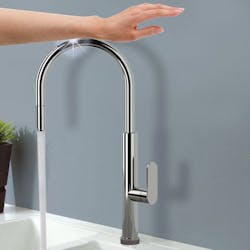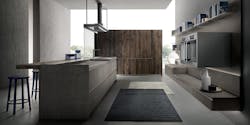What’s Trending in European Design?
Europe has long been a bellwether for cutting-edge kitchen and bath designs, so what trends are we seeing from the Continent today?
The importance of Europe as a hotbed of product development and design cannot be overstated—or overlooked. We can thank the continent for many of the current popular kitchen and bath trends, such as floating vanities, wall-hung toilets, in-wall flushing systems, linear drains, and large-format ceramic tiles in any number of designs.
Usually, trend ideas migrate west to New York City and Los Angeles and then filter to other American cities such as Chicago and Miami before they become popular in most regions. In the old days, this took some time, but ideas are reaching our shores a lot faster, as the global trade, travel, and design blogs have shrunk the world.
Made from solid surfacing, this round handmade lavatory is the world’s first bowl with an internal siphon, the company says. It makes it possible to mount the basin on a shelf or on a cabinet without having a siphon in sight. It’s available in five colors.
But why does Europe have such a strong reputation for producing great design and cutting-edge products? Designer Manuel Saez has a theory: Most countries in Europe have state-funded programs to support and promote design, he says.
Saez believes many European countries have populations that have design awareness and high corporate investment. As a result, consumers have higher expectations for good design, and manufacturers are forced to meet the demand—which is a stark contrast to the American market, he says.
“The American population is hard wired with a quick fix, ‘bigger-is-better’ mentality,” Saez wrote on fastcompany.com. “We are supporters of mega retailers that sell products that are cheap in terms of both price and aesthetic quality. This lack of design awareness has left American consumers with a different set of values and buying criteria. We do not ask—or demand—to buy good design because we do not understand what good design is.”
The Classic 2.0 is a cooktop that has an integrated downdraft. Users operate the unit by simply moving their finger up or down. The cooking surface offers enough space for four pots measuring up to 24 centimeters.
But American acceptance and demand for good design have improved significantly and have accelerated in the last 10 to 15 years. Architects, builders, and consumers are looking for cool design, which is why European products and European trends hold such currency here.
So what’s on the horizon? Look for more modern kitchens with cutting edge materials, ultra-thin countertops, and more wall-hung cabinets. Industrial-style faucets with exposed connections are returning, and customization is on the rise. More kitchens are blurring the lines between the living room, with hidden compartments for storing appliances and hiding sinks.
Like here, modern design is dominating the products coming from places such as Germany, Spain, and Italy—and even from The Netherlands and France. At last year’s Eurocucina show in Milan, manufacturers showed more modern wall hung-vanities with two legs to provide a hybrid look.
A version of this story ran on Custom Builder's sister publication residentialproductsonline.com.
The Base is a minimalist composite shower tray that measures as little as 1 inch. It comes in a variety of textures and a range of colors and can be specified with a non-slip surface.
The Château 150 is equipped with two gas-electric ovens and two large storage drawers. It has a stainless steel cooktop that can be configured to suit the homeowners’ needs.
The Vortex lavatory faucet features a unique hollow cyclic outlet that sucks in air to to create a waterfall effect and that’s visually appealing, the manufacturer says. It also helps to save water.
Powered by four AA batteries, this minimalist kitchen faucet can be activated by touch or it can run as a normal mixer by disconnecting the touch feature. A beep sound indicates a low battery warning.
IconColor is the third generation of Ernesto Meda's Icon cabinet line. Featuring aluminum parts, elements can now be customized in the 50 colors in gloss and flat lacquered finishes and with tons of accessories and storage options.
